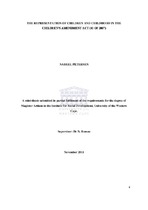| dc.description.abstract | Until fairly recently studies of children as actively engaged in the production of meaning making in their social lives has been overlooked, ignored or received marginal attention within the contemporary social sciences (Caputo 1995). There has since however been considerable growth in literature dedicated to extending our understanding of childhood (Hardman 1973; Caputo 1995; Waksler 1996; Morss 2002; Korbin 2003; Sawyer 2002). This has resulted in an emergent sense of legitimacy and focus on the role of children "as active and creative social actors" in society, particularly in the field of anthropology of children (Reis, 2006) and the establishment of the 'new' sociology of childhood. The point of departure for these emergent theoretical frameworks concern the traditional devaluing of childhood and children's perspectives in favour of "...a recurring set of dominant ideas within political and academic domains that draws a generational boundary between adults and children, in the process restricting children to subordinate and protected social roles" (Wyness 200:1 in Smith 2009:253). According to James & James (2004:76 in Smith 2009:252) law is a centrally important mediating influence in the social construction of childhood as vulnerable passive bystanders. This resonates with Moses who states that the rights prioritised for children within the South African Constitution are "protection-oriented conceiving children as vulnerable citizens rather than citizens with agency" (2008:329). Furthermore, according to Moses (2008:333) the conception of children in South African policy and that which underlies national service delivery, belies or contradicts perceptions of children as "active, meaning-makers, employing a range of coping strategies". This research therefore explores the representation of children and childhood within the Children‘s Amendment Act (41 of 2007); that is whether they are displayed as "active, meaning-making" citizens or passive vulnerable bystanders; and seeks to contrast that representation with the reality of children's worldviews, decision-making capabilities in their social lives in an attempt to highlight children as citizens with agency. The study used a qualitative exploratory approach which employed a range of qualitative research tools. Data was collected through a policy analysis, research workshops and focus 2 group discussions. Purposive sampling was used to compile a child sample composed of nine girls and ten boys. A social constructionist framework was used to thematically analyse the data. The results suggest that there are two general representations of children and childhood within the Act (41 of 2007); namely "the vulnerable child" and "the child as citizen and agent". The study offers recommendations for further research and improvements for service provision directed toward children, child welfare and childcare. | en_US |

